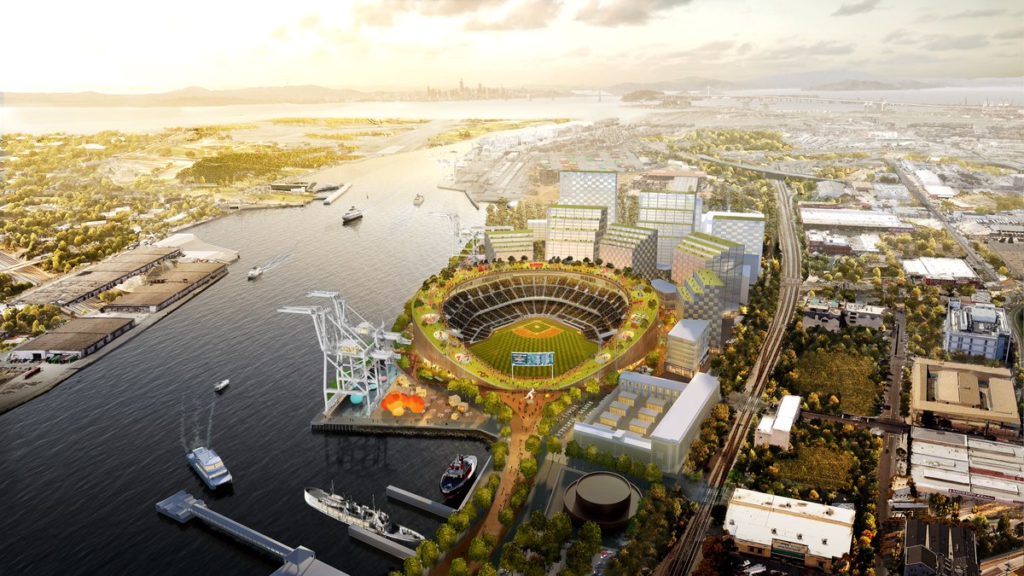
Instead of moving closer to a potential agreement on a new Howard Terminal ballpark deal, the Oakland A’s and Oakland officials are even farther apart on terms, with A’s President Dave Kaval expressing dissatisfaction with the talks.
With the release of a proposed term sheet by the city on Friday, the divide between the two sides was magnified and seemingly set in the stone, hailed by city officials and lambasted by the A’s. There was little surprising in the city’s term sheet, and the disagreements between the two sides are not new.
“We have some really big pieces here that are still outstanding, and while we’re always open to continuing to negotiate, we’re not in a position where this can work right now,” A’s President Dave Kaval told the East Bay Times.
As we noted earlier this month, one big disagreement between the two sides is the A’s proposal for two tax districts generating revenue for the project–one covering the Howard Terminal development site, one for the general area–that would be used to address infrastructure needs. There isn’t much debate about the tax district within the confines of the Howard Terminal project, but the proposal for an expanded tax district extending to Jack London Square and additional waterfront–areas that might not actually see much direct benefit traced directly to the ballpark project–is being opposed by the city. That’s one big split.
The other difference is one raising the ire of both community activists and elected officials: the team’s refusal to commit to funding affordable housing and community benefits as part of the project or, alternately, pay impact fees when the city has made affordable housing a priority (indeed, the need to include community housing is a city law now for all Oakland development, as well as subject to a state requirement as well). The response from Kaval: the team may use the proceeds of a new aforementioned tax to pay for affordable housing or impact fees–which means Oakland citizens, and not the team, would be paying the impact fee or affordable-housing costs.
To review: the A’s have proposed a $12-billion development at the downtown Howard Terminal waterfront site. The proposal, first unveiled three years ago, calls for a Howard Terminal waterfront development that, according to the team, will feature $12 billion in private investment, including a billion dollars for a new 35,000-capacity ballpark to replace the Coliseum. The development would also include 3,000 units of housing, as well as 1.5 million square feet of office space, 270,000 square feet of retail space, a 400-room hotel, 18 acres of parkland and an estimated $450 million in community benefits. Also, the team would buy the remaining half interest in the Coliseum site it does not own and redevelop that area as well–but that’s not a done deal, either. The city is expected to vote on the term sheet–in a nonbinding vote–at its July 20 meeting. This would allow the two sides to continue negotiations.
Also, if Oakland and the A’s bridge their differences, there’s also another looming battle here: Alameda County must also sign off on any Howard Terminal development deal. The county could take up the proposal as soon as September. And after that will be the results of a environmental impact study.
Something the city needs to decide: whether Howard Terminal development is the only way to keep the A’s, or if the threat of a Las Vegas move is real. MLB Commissioner Rob Manfred says it is–of course he’s going to say that!–but the team has also rejected the idea of building a new ballpark at the current Oakland Coliseum site, a plan favored by many Oakland residents.
“John Fisher and Major League Baseball have done everything humanly possible to get a stadium built in Oakland,” Manfred said during his annual press conference at last week’s All-Star Game. “At the point in time that you come to the conclusion that it can’t get done, whether you like the market or not, you have to find someplace else to play because you need a facility. It’s that simple.”
However, finding funding for a new Las Vegas ballpark has its own challenges, and the team plans another Vegas run immediately after the July 20 meeting to shake the money tree yet again. We have not heard much optimism from local officials on the prospects of a ballpark funding plan. There’s talk that Henderson officials are eager to discuss a private-public partnership on a new ballpark, but there is plenty of skepticism about Henderson being the ideal location for an MLB ballpark.
RELATED STORIES: Las Vegas Ballpark as MLB home? Maybe, maybe not; A’s braintrust plans third Vegas run; A’s struggle with attendance, even with full Coliseum capacity; Who could pay for a new Las Vegas A’s ballpark? It’s a very short list; A’s schedule fact-finding trip in Las Vegas; After ultimatum, Oakland officials say they will consider A’s ballpark plan; With A’s in play, what comes next?; MLB to A’s: Feel free to leave Oakland; Oakland A’s: Time to move forward with new ballpark; It’s MLB expansion time again, with another Portland ballpark plan unveiled; Nashville MLB effort adds another big name: Darius Rucker; Manfred Discusses MLB Expansion; Is Nashville a Contender?; EIR draft details benefits of new waterfront Athletics ballpark; A’s prevail in Howard Terminal lawsuit; still, construction likely delayed; Sierra Club: Build A’s ballpark at Coliseum site, not Howard Terminal
